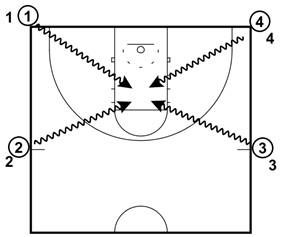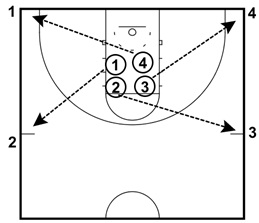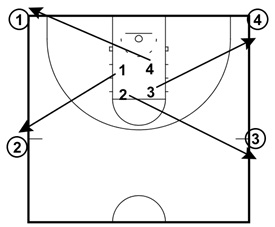Four Corner Pass and Pivot Drill
The following drill works on your players' passing and receiving skills as well as teaching how to pivot properly. The four corner pivot passing drill, diagramed below, should be run at half speed to begin with, eventually getting into full speed as your players become accustomed to the positions and rotations.
Here is a video of the drill from Coach Jim Huber. Jim Huber developed The Ultimate Resource for Man to Man Defense and is our Director of Coaching Development for Breakthrough's Youth Basketball Camps and Elite Guard Camps.
Instructions

Step 1:
The drill begins with players lining up in four lines, two lines at the baseline and two on the sideline extended from the top of the three point line. The players in the front of the lines will begin with a basketball (as represented by the four players with a circle around them on the right).
All four players with the ball will dribble with their right hand only to the center of the key.

Step 2:
When the players get to the key they will jump stop and pivot on their right foot and step through with their left foot.
All four players will make a chest pass to the line that is now in front of them (1 will pass to 2, 2 will pass to 3, 3 will pass to 4 & 4 will pass to 1, as shown to the right). The players will be passing to the corner in a counter clockwise rotation.
The player receiving the basketball should step into the pass to meet the ball in a triple threat position.
To work on team communication, the players passing the ball should yell out the name of the player they are passing to.

Step 3:
After making the pass, all four players will sprint to the back of the line that they just passed to.
As your players learn the proper rotation, encourage them to sprint as hard as they can. This will work on your team′s conditioning and will keep the drill in constant motion.

Step 4:
The drill then restarts from the beginning and repeats the same steps from above. The four players that are now in the front of the line dribble to the center of the key and jump stop before pivoting on their right foot and passing to the next line.
This drill can be run in the opposite direction, with the players dribbling with their left hand, pivoting on their left foot and stepping through with their right foot. They will now pass to the player in a clockwise rotation.
To progress the drill, you can teach your players how to reverse pivot and have them incorporate the reverse pivot into the passing scheme. Similar to the steps above, the drill will be run with a right handed dribble, a reverse pivot on the right foot and a pass to the player in a counter clockwise rotation. The drill can also be run with a left handed dribble, a reverse pivot on the left foot and a pass to the player in a clockwise rotation.
This drill works great in practice as well as during pre-game warm ups. It also works on teaching young kids how to pivot, which can be a lost skill for many basketball players.
To get FREE 72 Winning Basketball Drills eBook, click the banner below
What do you think? Let us know by leaving your comments, suggestions, and questions. . .
|
|||||||||||||||||||




 Facebook (145k Followers)
Facebook (145k Followers) YouTube (152k Subscribers)
YouTube (152k Subscribers) Twitter (33k Followers)
Twitter (33k Followers) Q&A Forum
Q&A Forum Podcasts
Podcasts